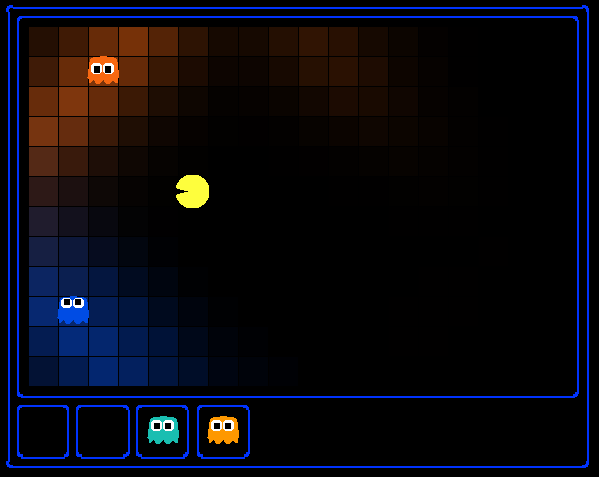
Running won't save you from my
Particle filter!

I can hear you, ghost.
Running won't save you from my
Particle filter!
Pacman spends his life running from ghosts, but things were not always so. Legend has it that many years ago, Pacman's great grandfather Grandpac learned to hunt ghosts for sport. However, he was blinded by his power and could only track ghosts by their banging and clanging.
In this project, you will design Pacman agents that use sensors to locate and eat invisible ghosts. You'll advance from locating single, stationary ghosts to hunting packs of multiple moving ghosts with ruthless efficiency.
The code for this project contains the following files, available as a zip file.
bustersAgents.py |
Agents for playing the Ghostbusters variant of Pacman. |
inference.py |
Code for tracking ghosts over time using their sounds. |
busters.py |
The main entry to Ghostbusters (replacing Pacman.py) |
bustersGhostAgents.py |
New ghost agents for Ghostbusters |
distanceCalculator.py |
Computes maze distances |
game.py |
Inner workings and helper classes for Pacman |
ghostAgents.py |
Agents to control ghosts |
graphicsDisplay.py |
Graphics for Pacman |
graphicsUtils.py |
Support for Pacman graphics |
keyboardAgents.py |
Keyboard interfaces to control Pacman |
layout.py |
Code for reading layout files and storing their contents |
util.py |
Utility functions |
Files to Edit and Submit: You will fill in portions of inference.py and bustersAgents.py
during the assignment. You should submit these files with your code and comments in .zip or .tar.gz files. Please do not change the other files in this distribution or submit any of our original files other than these files.
Evaluation: Your code will be autograded for technical correctness, using the same autograder and test cases you are provided with. Please do not change the names of any provided functions or classes within the code, or you will wreak havoc on the autograder. You should ensure your code passes all the test cases before submitting the solution, as we will not give any points for any questions if not all the test cases for it pass. However, the correctness of your implementation -- not the autograder's judgements -- will be the final judge of your score. Even if your code passes the autograder, we reserve the right to check it for mistakes in implementation, though this should only be a problem if your code takes too long or you disregarded announcements regarding the project.
Academic Dishonesty: We will be checking your code against other submissions in the class for logical redundancy. If you copy someone else's code and submit it with minor changes, we will know. These cheat detectors are quite hard to fool, so please don't try. We trust you all to submit your own work only; please don't let us down. Likewise, do not attempt to write your code specifically to pass the autograder's tests. Either copying or trying to cheat the autograder will be considered violations of the student honor code.
Getting Help: You are not alone! If you find yourself stuck on something, contact the course staff for help. Office hours and Piazza are there for your support; please use them. If you can't make our office hours, let us know and we will schedule more. We want these projects to be rewarding and instructional, not frustrating and demoralizing. But, we don't know when or how to help unless you ask.
Discussion: Please be careful not to post spoilers.